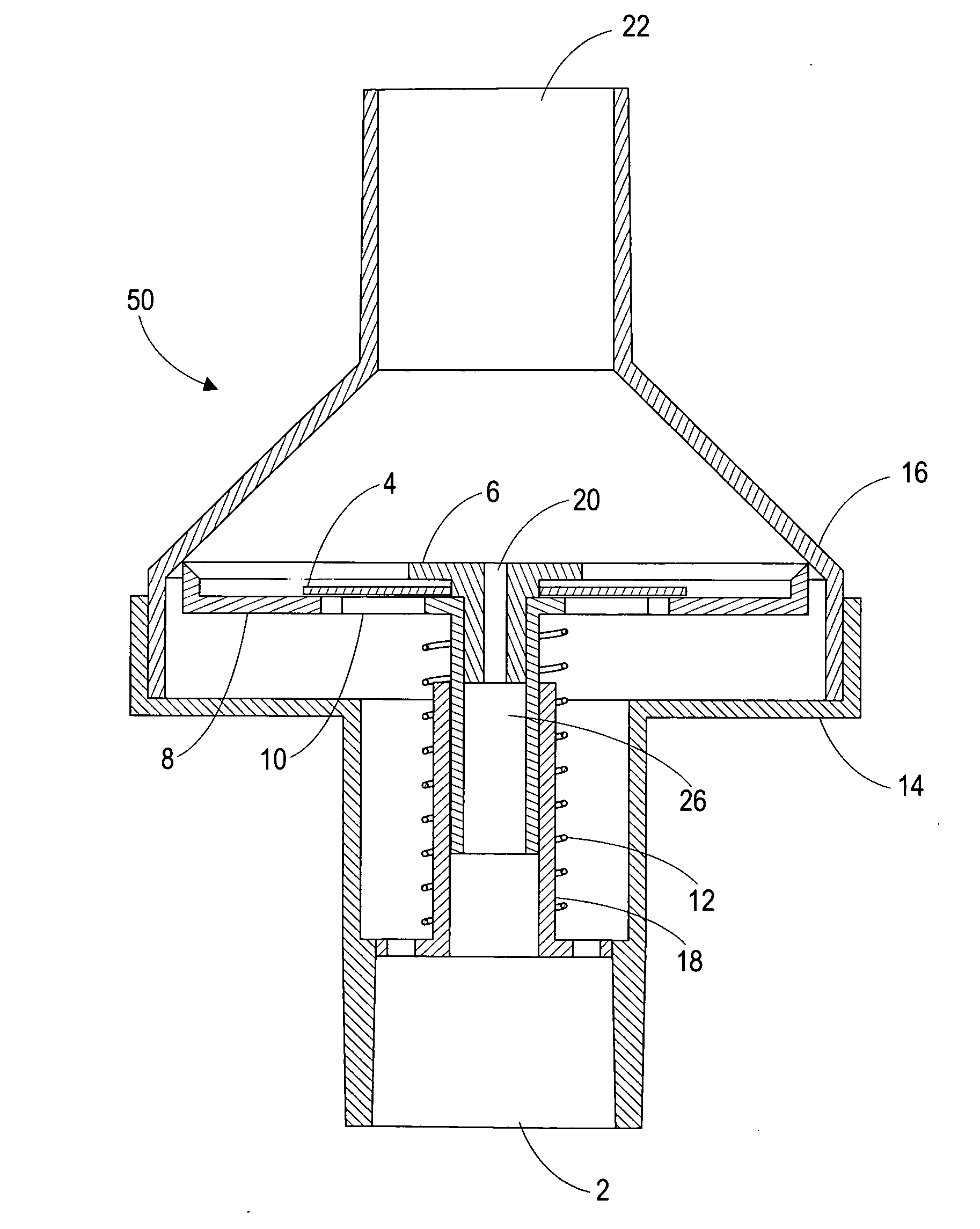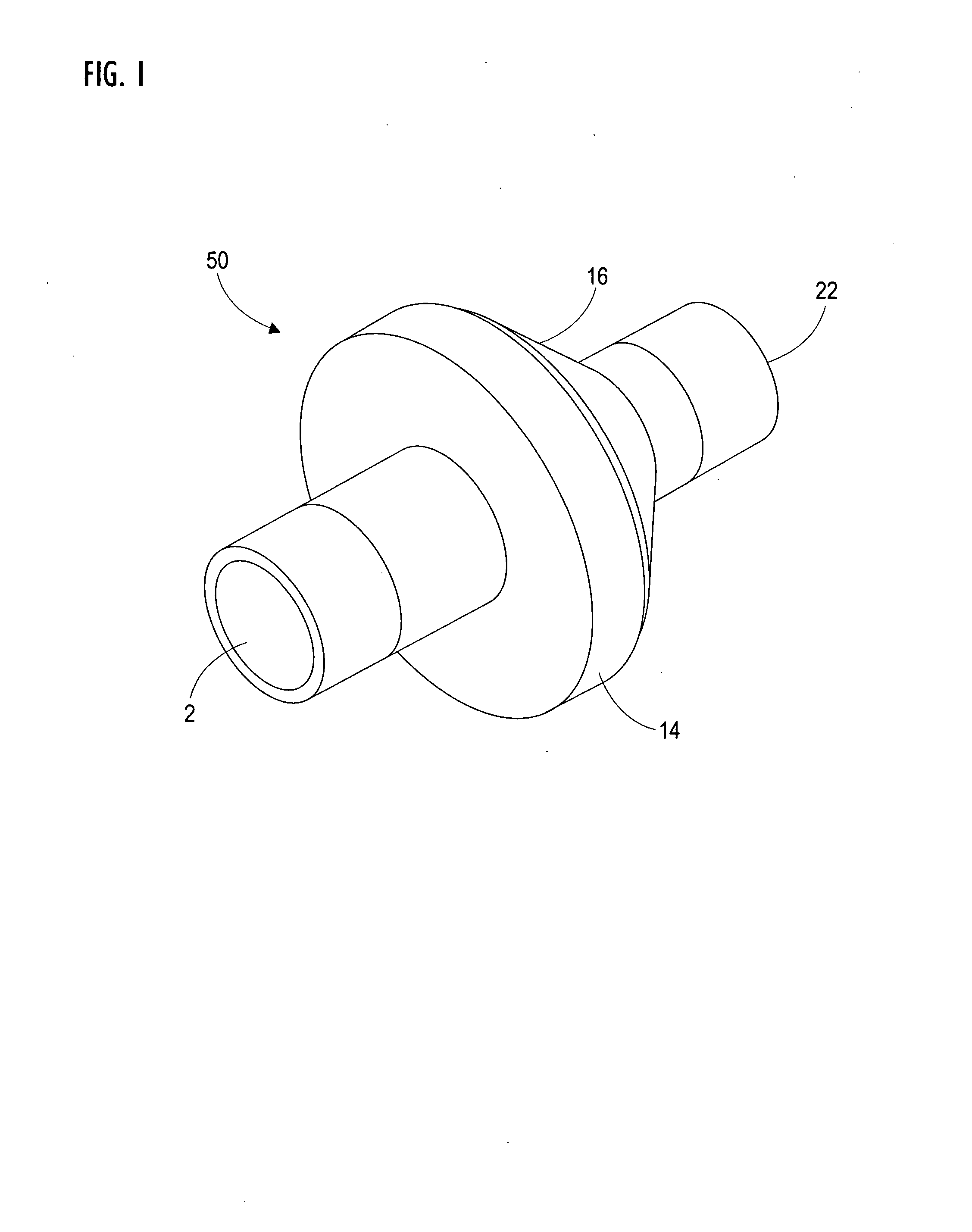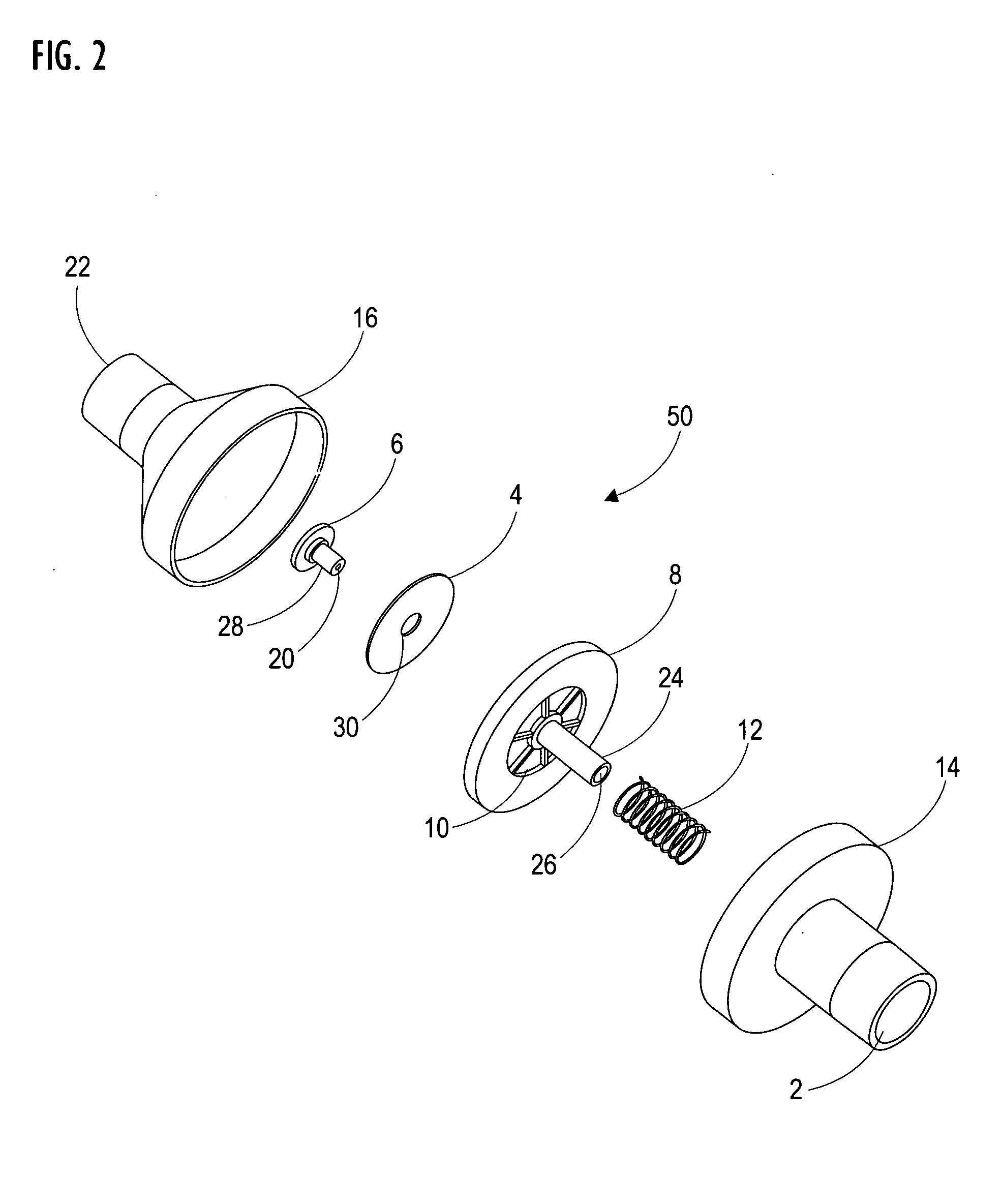[0014]In a first embodiment, a patient connector is in fluid communication with a cross-seal vent valve
assembly, wherein the valve
assembly comprises a valve
piston associated with and biased against an
exhalation port of the
assembly and a
check valve is associated within the valve
piston which allows for controlled
gas release. The valve
piston base engages upon an interior aspect of a valve assembly cap. The valve piston is maintained against an interior aspect of a valve assembly cap by the force exerted by a biasing means (e.g. helically wound spring), though it is within the purview of the present invention that the biasing means can be mechanically or electronically adjusted through manual, semi-automated and
fully automated processes. The biasing means is retained in the assembly by a
piston guide, which itself includes a plurality of atmospheric vents. As pressure from a chest compression (or induced
tidal volume) through a patient connector through the valve base and against the valve piston base,
exhalation gas is dispersed through the
check valve. A vacuum is then developed within the valve assembly as a result of elastic expansion of the intrathoracic chamber which is held in check by the biasing means. The biasing means maintains the valve piston closed until an initial threshold pressure is exceeded. Once the pressure exceeds the force exerted by biasing means, the valve piston will translate from a closed to an open condition, and will remain open until sufficient pressure is dissipated as to allow biasing means to return the valve piston base to a closed position against the interior aspect of the valve assembly cap. The rate at which the pressure drops from the opening pressure to the closing pressure is regulated in part by the restrictive value of cross-seal vent associated with the assembly. Conversely, the cross-seal vent allows for continuous pressure regulation in both
exhalation (increased pressure) and
inhalation (reduced pressure), which in combination with the valve piston, allows for
variable pressure rates during
cycling and, importantly, allows the valve assembly to reset to anatomical norms for improved cardiac flow.
[0015]It is critical to note that the operation of the aforementioned valve assembly allows for an initial higher pressure to cause the piston to open and to then subsequently allow a second lower pressure being achieved due to
equalization flow through the cross-seal vent. By setting the threshold pressure and the restriction to flow of the cross-seal vent patient parametrics, including
lung capacity, the pressure within the intrathoracic region can be specifically regulated. Those skilled in the art can appreciate that a number of alternate piston and biasing schemes could be employed without departing from the nature of the invention. By impeding
inhalation gas flow, the present invention specifically regulates the application and retention of
vacuum pressure within the
thorax, which is briefly maintained and then relinquished in a controlled and regulated manner, eventually allowing the pressure in the
thorax to return to an ambient baseline state due to the
equalization flow through the cross-seal vent. This is superior to normal CPR techniques without the invention as in such a case the CPR compression would primarily be functioning to simply push gas in and out of the patient's lungs and thus would result in far less pressure variance in the
thorax, resulting in far less
blood flow through the thorax. Furthermore, the invention has the further
advantage of providing feedback to the clinician or operator on whether sufficient chest compression has been supplied (as indicated by movement of the piston).
[0018]According to the present invention, use of a finitely regulated cross-seal vent valve assembly can be readily employed for increasing cardiopulmonary circulation induced by chest compression and decompression when performing
cardiopulmonary resuscitation. Particularly advantageous is in the use of a cross-seal vent valve assembly biased against patient
inhalation, and any one of the described (equivalent / alternate) control means biased against patient inhalation, is that a “transient pressure vacuum window” can be created in the cycling of the negative pressures formed in the intrathoracic region of a patient during CPR. This “transient pressure, vacuum window” is a point where, due to biasing of the respective control means of a cross-seal vent valve assembly attached to the
respiratory system of a patient, regulated inhalation can occur within a finite set of conditions and therefore a set negative pressure is retained within the intrathoracic region for a finite period of time thus enhancing cardio-pulmonary flow. The methods and devices may be used in connection with any generally accepted CPR methods or with active compression-decompression (ACD) CPR techniques. When a valve assembly in accordance with the present invention is used with CPR methods, the “transient pressure vacuum window” automatically coincide with steps in the CPR method such that less force is lost in movement of air volumes from the patient's
thoracic region and incremental pressure gains are achieved in inducing circulation of oxygenated blood in the patient (measured as
blood flow).
[0019]Cardiopulmonary circulation is increased according to the invention by impeding air flow into and / or out of a patient's lungs during the compression and / or decompression phase. This increases the magnitude and prolongs the duration of positive and / or negative intrathoracic pressure during compression and the subsequent decompression of the patient's chest and result in increases of
venous blood flow into the heart and lungs from the
peripheral venous vasculature during decompression and also results in increases in oxygenated blood leaving the thorax during compression. Thus the present invention results in the greater inflow and outflow of blood through the heart and
lung corresponding with the
initiation of compression and decompression accompanying CPR rather than the diminished
blood flow and the increased flow of gases coming in and out of the
lung that would result without the invention. As the inventive concept provides for a return to a baseline
lung pressure prior to the each subsequent chest compression, the invention has the further
advantage over other technologies of still allowing
gas exchange as a result of CPR and works harmoniously with various ventilation technologies and artificial
breathing techniques.
[0021]When performing
cardiopulmonary resuscitation to enhance circulation according to the invention, an operator compresses a patient's chest to force blood out of the patient's thorax. The patient's chest is then decompressed to induce
venous blood to flow into the heart and lungs from the
peripheral venous vasculature either by actively lifting the chest (via ACD-CPR) or by permitting the chest to expand due to its own elasticity (via conventional CPR). During the decompression step, air flow is impeded from entering into the patient's lungs which enhances negative intrathoracic pressure and increases the time during which the thorax is at a lower pressure than the
peripheral venous vasculature. Thus,
venous blood flow into the heart and lungs from the peripheral venous vasculature is enhanced during decompression as a result of enhanced venous return rather than from inflow of air via the trachea. In a particular embodiment, compression and decompression of the patient's chest may be accomplished by pressing an applicator body against the patient's chest to compress the chest, and lifting the applicator to actively expand the patient's chest.
 Login to View More
Login to View More  Login to View More
Login to View More 


